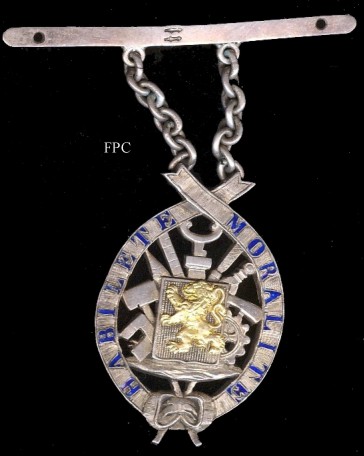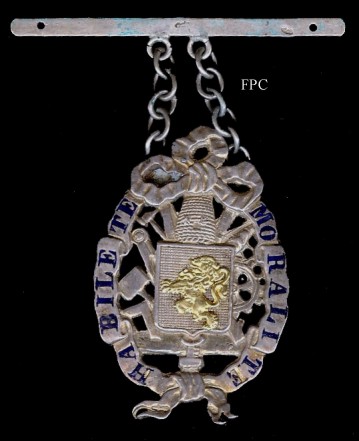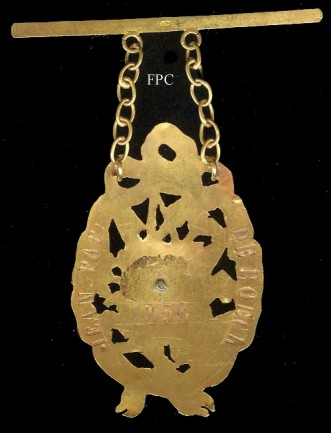

Other Belgian medals instituted during the Reign of King Leopold I
When Belgium became independent in September 1830, the practice of awarding non-wearable medals for courage, dedication and humanity, as it existed during the Dutch occupation, was at first maintained. "Table" medals in gold, silver or bronze (according to the importance of the act) with the effigy of the new monarch, King Leopold I, were struck to replace the Dutch ones. In 1835 the first appearance of wearable medals was noted : the table medals were surrounded by a metal circle of the same material as the medal and attached to a ribbon reflecting the Belgian national colours, black with side stripes in yellow (inner) and red (outer). In the early 1840's the first medals on a ball and ring suspension were manufactured. At about the same time the first medals with a mural crown suspension were produced by some enterprising medal manufacturers. |
Example of an 1837 award, privately mounted in a silver ring |
In those early years of the Kingdom of Belgium, several decrees were made, detailing sizes and other specifications for these medals but in spite of them, several other types and sizes are found. By Royal Decree of 19 April 1849 the mural crown suspension was officially instituted and, somehow, the bronze medal seems to have disappeared ... This type of the medal (aka 3rd type) can be found with the engraver's mark ("H") or name ("HART F.") under the King's shoulder on the obverse although medals without mark or name do exist. Finally, as King Leopold I died in 1865, a new medal with the effigy of his successor, Leopold II, was struck. In 1867, however, Leopold II instituted the Civic Decoration for the same purpose and this 4th type was rendered obsolete. Because of their short lifetime, medals of this last type are very rare. The Medal for Courageous Acts, Dedication and Humanity were awarded for an act of humanity or devotion to duty or, of course, courage in saving life or avoiding catastrophes (quenching fires, etc.) whereby one put one's own life to risk. One such medal, of the mural crown suspension type, was awarded to a Mr. Hurst of Margate, England in 1860.
The reverse inscription reads : "V.H. HURST / EN VUE / DE RAMSGATE / 15 JANV. / 1860". The award was duly published in the Belgian official journal (Staatsblad) and refers to the Royal Decree of 15 September 1861 and Ministerial Decree No. 267 of 24 September 1861 awarding the medal to Mr. Hurst and similar silver medals to the crews of the two boats that went to rescue the Daniel's crew. My thanks to Werner Van Brempt for providing this information.
|
![]()
A number of non-wearable medals were struck to reward those that rendered distinguished services during the cholera epidemic that raged in Belgium in 1832. These were in either gold, silver gilt, silver or bronze according to the importance of the services rendered. However, a small number of medals, fitted with a ball suspension and ring, were manufactured and suspended from a 5-stripe ribbon in the national colours (red - yellow - black - yellow - red). |
 |
 |
 |
![]()
Originally, on 23 November 1833, this medal was officially created as a non-wearable prize medal for the most distinguished students at the Veterinary and Rural Economy School, in bronze, silver or silver gilt. Shortly after, however, in 1834-35, a wearable version was also struck. It would appear that these medals were only awarded once, after the exams of the 1833 school year. |

 |
 |
In order to recognize exceptional bravery but mostly to denote being wounded during the combats for independence in 1830, the Iron Cross and the Iron Medal were created on 30 December 1833. Soon afterwards, in August 1834 the Iron Medal was replaced by the Iron Cross 2nd class, the original Iron Cross becoming the 1st class. Whereas the 1st class cross had a gold (or silver gilt) centre, the 2nd class had one in sterling silver. However, the Iron Medal did not disappear as it was made into a souvenir medal accompanying the award of the Iron Cross. This division in classes didn't survive long either and, on 21 February 1835, it was decreed that the 2nd class cross was abolished and everyone entitled to it would receive the original cross. In all, some 1,635 Iron Crosses are supposed to have been awarded. |
![]()
Instituted on 19 October 1840 in a 1st (gold) and 2nd (silver) class, the first type of this medal shows King Leopold I in military uniform on the obverse. In 1847 this was changed to the laureated head of the king and in 1849 a mural crown suspension was added. The fourth and final type, also on a mural crown suspension, was created in 1866 and bears the head of King Leopold II. On the institution of the Civil Decoration in 1867, this medal ceased to be awarded. |

![]()
In order to reward the services rendered by physicians, surgeons, midwifes and apothecaries during epidemics, medals in bronze, silver and gold were instituted on 12 October 1846. These original medals were non-wearable but the third type, struck in 1849, was made wearable. A fourth type, slightly smaller than the 3rd type, was created in 1860 and served till 1867 when the Civil Decoration replaced it. |
 |
 |
 |
Epidemics Medal, non-wearable type - Pictures kindly provided by Gerald Klassen |
||
Decoration for Labourers and Artisans
First instituted on 7 November 1847 for award during industrial exhibitions to those that have satisfied the exhibition's jury members of their expertise in manufacturing a product exhibited. Over the years 3 different types of this award were made, all consisting of a badge suspended from a double chain affixed to an horizontal bar (and not hanging from a ribbon as in the picture immediately below). The reverse of the medal bears the recipient's name and the year of award, the obverse shows a variety of tools with the Belgian lion crest in front and surrounded by a ribbon with the words "HABILETE" and "MORALITE" in blue enamel. The depicted badge is the third type, first used in 1861. The badge was awarded in two classes : a silver badge for a first award and a gold badge for a second award.
My warmest thanks to Mr. Michel Bafort for the above pictures of this award (an 1861 type late award to a Mr. John Philips for the 1849 exhibition). To further illustrate the evolution and varieties encountered : |
 |
 |
 |
 |
 |
 |
 |
 |

King Leopold I instituted this award on 20 July 1856 in two classes, a cross and a medal. The cross was awarded to officers on active duty who had, on 21 July 1856, reached 25 years of continuous active service. The medal went to NCO's or soldiers under the same condition. It is understood that some 1,000 of each were actually awarded between 1856 and 1860. |
![]()
Instituted on 10 March 1857 for award to prison officers for good conduct and acts of dedication or for exemplary conduct or bravery in either gold or silver. Over the years the design would change with each reigning monarch and the mural crown suspension would become a royal crown one during the reign of King Albert I. Under King Leopold III, the metal used would become bronze gilt or silvered bronze. |

The Industrial and Agricultural Decoration (later, the Labour Decoration)
Awarded for long service in industry (blue enameled wreath) or in agriculture (green enameled wreath), in two classes, Gold for 30 years, Silver for 25 years service, this decoration was originally instituted on 7 November 1847 and has changed its form as well as its title to the present 1958 form. |
Copyright Hendrik Meersschaert 2024 ©